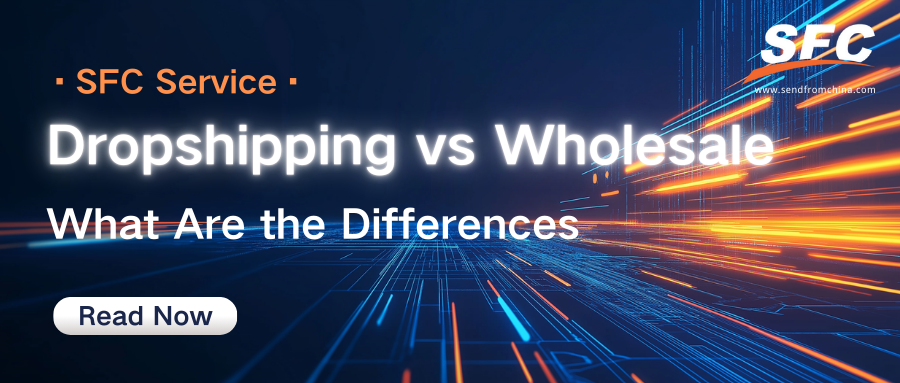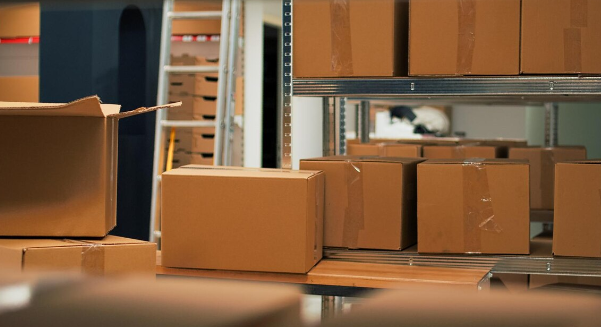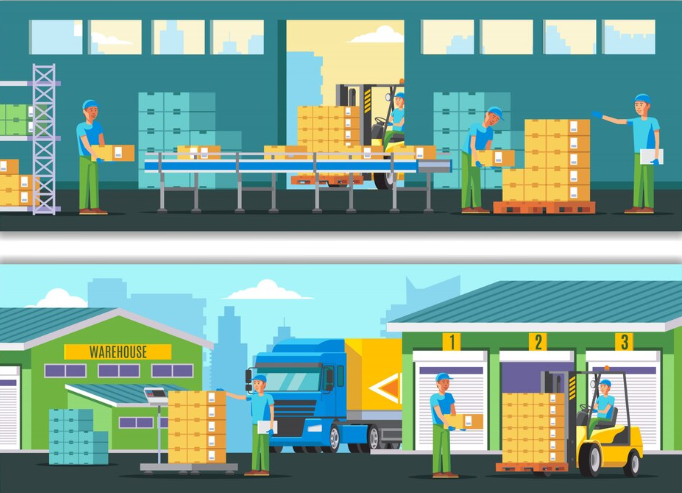Table of Contents
Get Custom eCommerce Fulfillment Service
Book a Meeting
What Are the Differences Between Dropshipping and Wholesale
Time: Oct 22,2024 Author: SFC Source: www.sendfromchina.com
The debate between dropshipping and wholesale is one many eCommerce entrepreneurs face when choosing the right business model. Each has its own set of benefits, risks, and operational requirements.In this guide, we will explore the major differences between dropshipping and wholesale, giving you a clear understanding of which model will best suit your needs. From startup costs to profit margins, discover everything you need to know to make an informed decision for your eCommerce store.

1. Understanding What Is Dropshipping
Dropshipping is an eCommerce business model where retailers do not keep the products they sell in stock. Instead, they partner with suppliers who handle inventory, shipping, and sometimes even customer service. The retailer's role is to market the products, list them on their online store, and place orders with the supplier when a sale is made.Dropshipping allows businesses to operate without the need for a physical inventory or warehousing, making it a low-risk entry point into the world of eCommerce. The dropshipping model is especially popular with entrepreneurs who are just starting out, as it significantly reduces upfront costs.
Key Features of Dropshipping
No Inventory Management: Retailers don’t have to manage stock, as the supplier takes care of it.Low Startup Costs: There’s no need for upfront inventory investment, making dropshipping more accessible.
Flexible Product Range: Businesses can offer a wide variety of products without holding any physical inventory.
Third-Party Fulfillment: Shipping and logistics are handled by the supplier.
2. Understanding What Is Wholesale

Unlike dropshipping, in the wholesale model, the business is responsible for storing inventory, managing fulfillment, and overseeing customer service. Wholesale operations often require larger capital investment upfront due to the need for warehousing and inventory purchasing.
Wholesalers primarily serve as intermediaries between manufacturers and retailers, offering products at a price lower than retail but higher than the manufacturer’s cost.
Key Features of Wholesale
Bulk Purchasing: Businesses buy large quantities of products at a lower per-unit price.Inventory Management: Retailers who use wholesale must store and manage their inventory.
Higher Profit Margins: Wholesale generally offers larger profit margins due to bulk pricing.
Control Over Fulfillment: Retailers oversee shipping, handling, and customer service.
3. Working Models of Dropshipping and Wholesale

How the Dropshipping Model Works
Supplier Relationship: Dropshipping businesses partner with suppliers who hold stock and manage fulfillment.Customer Ordering: When a customer makes a purchase, the retailer processes the order and relays it to the supplier.
Supplier Fulfillment: The supplier ships the product directly to the customer on behalf of the retailer.
Retailer Profits: The retailer makes a profit by charging a higher retail price than the supplier's wholesale price.
How the Wholesale Model Works
Bulk Purchase from Manufacturers: Wholesalers purchase large quantities of products at a discounted rate.Inventory Storage: The retailer holds and manages their stock in a warehouse or storage facility.
Customer Order Fulfillment: Orders are shipped directly by the retailer from their own inventory.
Profit Margin: The retailer earns a profit by selling the product for more than the wholesale cost.
4. Advantages of Dropshipping and Wholesale

Advantages of Dropshipping
Lower Upfront Costs: Since dropshipping requires no inventory, businesses don’t need to invest in stock or warehousing.Reduced Risk: Retailers are not stuck with unsold inventory, as they only purchase products once a sale is made.
Scalability: Businesses can easily expand their product offerings and market reach without increasing overhead costs.
Location Flexibility: Dropshipping allows businesses to operate from anywhere, as long as there’s internet access.
Advantages of Wholesale
Higher Profit Margins: By purchasing in bulk, businesses can secure a lower per-unit cost, leading to larger margins on each sale.Inventory Control: Retailers can inspect products firsthand and ensure quality control before they reach customers.
Customer Satisfaction: Faster shipping times, since retailers manage inventory and fulfillment directly.
Branding Opportunities: With wholesale, retailers can offer branded packaging and a more customized customer experience.
5. Disadvantages of Dropshipping and Wholesale
Disadvantages of Dropshipping
Lower Profit Margins: Since suppliers handle much of the logistical work, the profit margins are generally lower than wholesale.Lack of Control: Retailers have limited control over product quality, shipping times, and customer service.
Supplier Dependency: If a supplier runs out of stock or has issues fulfilling orders, the retailer is left to handle the fallout.
Highly Competitive: The low barrier to entry means that many dropshipping businesses face stiff competition, often leading to price wars.
Disadvantages of Wholesale
High Upfront Costs: Wholesale requires significant capital investment for inventory purchasing and storage.Inventory Risk: Retailers must manage the risk of unsold inventory, which could lead to losses if demand doesn’t meet expectations.
Operational Complexity: Wholesale involves more complicated logistics, including inventory management, warehousing, and shipping.
Limited Flexibility: Retailers are limited by the stock they’ve purchased, making it difficult to adapt to changing market trends.
6. Key Differences Between Dropshipping and Wholesale

1. Inventory Management
- Dropshipping: No inventory is held by the retailer. The supplier manages stock and fulfillment.- Wholesale: The retailer holds and manages their own inventory, requiring warehouse space.
2. Startup Costs
- Dropshipping: Low startup costs since businesses don’t need to purchase stock upfront.- Wholesale: High upfront costs due to the need for bulk purchasing and storage solutions.
3. Profit Margins
- Dropshipping: Generally offers lower profit margins because suppliers handle much of the fulfillment process.- Wholesale: Higher profit margins, as retailers purchase products in bulk at a lower per-unit cost.
4. Control Over the Supply Chain
- Dropshipping: Retailers have minimal control over shipping, product quality, and inventory management.- Wholesale: Retailers control the entire supply chain, allowing for better quality assurance and faster shipping.
5. Risk
- Dropshipping: Reduced risk since retailers don’t need to invest in inventory upfront. However, there’s a risk of poor supplier performance affecting customer satisfaction.- Wholesale: Higher risk due to significant upfront investment in inventory and warehousing, with the potential for unsold stock.
6. Scalability
- Dropshipping: Easy to scale, as businesses can offer a wide range of products without increasing operational complexity.- Wholesale: Scaling requires more resources, including larger storage spaces and more inventory, making it more challenging.
7. FAQs
1. Which model is better for beginners, dropshipping or wholesale?
Dropshipping is generally better for beginners because of its low startup costs and minimal risk. It allows new entrepreneurs to test the waters of eCommerce without a significant upfront investment.2. Can I switch from dropshipping to wholesale later on?
Yes, many businesses start with dropshipping to build a customer base and switch to wholesale once they have the capital and infrastructure to manage their own inventory.3. Are there any legal requirements for running a dropshipping business?
While dropshipping itself doesn’t require special licenses, businesses must still comply with general eCommerce laws, such as registering their business and paying taxes. It’s also important to work with reputable suppliers to avoid legal issues with counterfeit products.4. Is it possible to combine dropshipping and wholesale in one business?
Yes, some retailers use a hybrid model, offering some products via dropshipping while holding inventory for others. This allows for flexibility while maximizing profit margins where possible.5. What types of products are best suited for dropshipping?
Low-cost, high-demand products such as fashion items, electronics accessories, and home goods are commonly dropshipped. These products tend to have lower shipping costs and fewer quality control issues. Post Views:5452
Post Views:5452
Copyright statement: The copyright of this article belongs to the original author. Please indicate the source for reprinting.
Previous Post
What Is Dropshipping? The Ultimate Guide
Next Post
TAGS
Hot Research
Recent News
Get Custom eCommerce Fulfillment Service
Book a Meeting
Get a Custom China Fulfillment Solution with FREE Storage for 30 Days
 Want to know about our services, fees or receive a custom quote?
Want to know about our services, fees or receive a custom quote?
 Please fill out the form on the right and we will get back to you within a business day.
Please fill out the form on the right and we will get back to you within a business day.
 The more information you provide, the better our initial response
will be.
The more information you provide, the better our initial response
will be.





 TAGS:
TAGS: